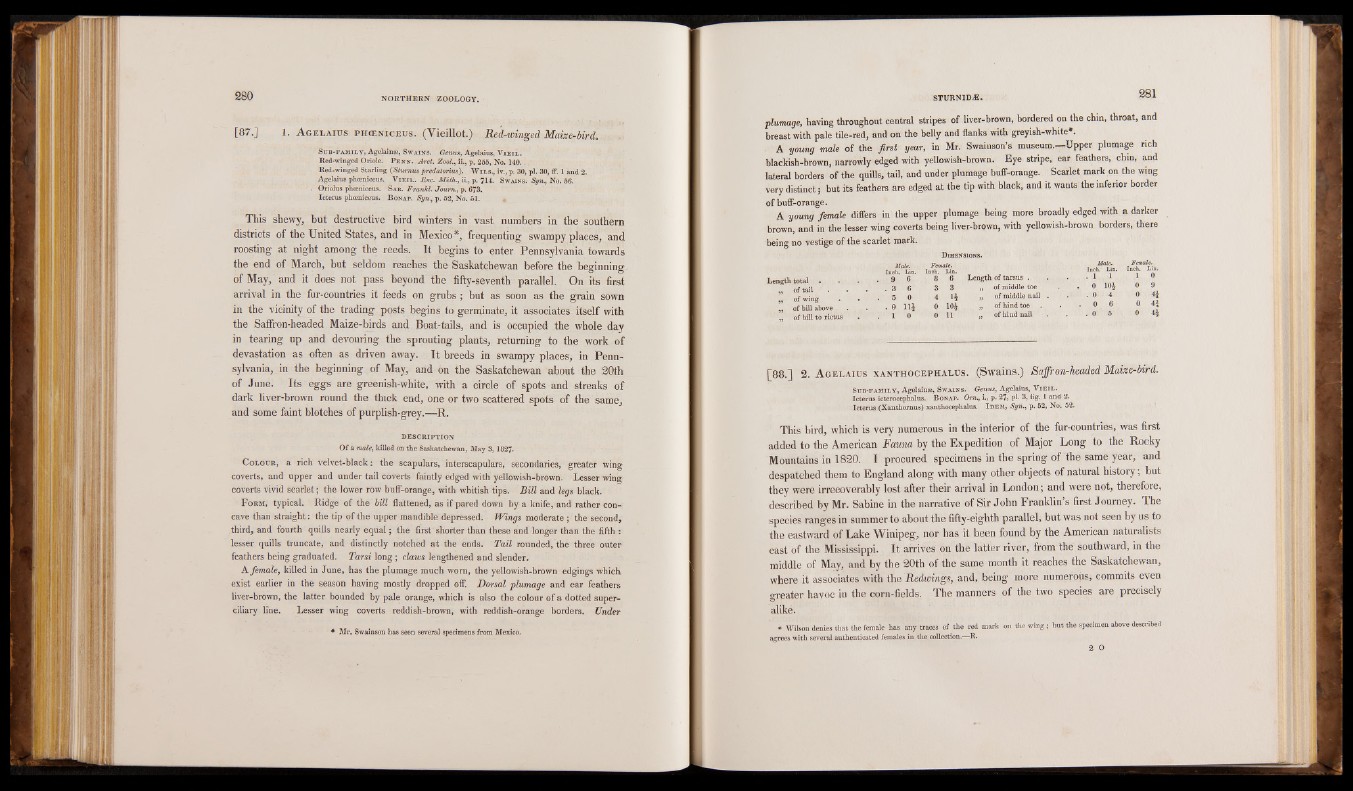
[87.] 1. Agelaius phceniceus. (Yieillot.)- Red-winged Maize-bird.
Su b -f a m il y , Agelainse, Swains. Genus, Agelaius, Vi e i l .
Red-winged Oriole. P e n n . Arct. Zool., ii., p. 255,. No. 140.
Red-winged Starling (Stumus predatorius). Wins., iv., p. 30, pi. 30, ff. 1 and 2.
Agelaius phceniceus. Vi e i l . Enc. Math., ii., p. 714. Swains. Syn., No. 56.
. Oriolus phceniceus. Sab. Frankl. Journ., p. 673.
Icterus phceniceus. B onap. Syn., p. 52, No. 51.
This shewy, but destructive bird winters in vast numbers in the southern
districts of the United States, and in Mexico *, frequenting swampy places, and
roosting at night among the reeds. It begins to enter Pennsylvania towards
the end of March, but seldom reaches the Saskatchewan before the beginning
of May, and it does not pass beyond the fifty-seventh parallel. On its first
arrival in the fur-countries it feeds on grubs; but as soon as the grain sown
in the vicinity_of the trading posts begins to germinate, it associates-itself with
the Saffron-headed Maize-birds and Boat-tails, and is occupied the whole day
in tearing up and devouring the sprouting plants, returning to the work of
devastation as often as driven away. It breeds in swampy places, in Pennsylvania,
in the beginning of May, and on the Saskatchewan about the 20th
of June. Its eggs are greenish-white, with a circle of spots and streaks of
dark liver-brown round the thick end, one or two scattered spots of the same,
and some faint blotches of purplish-grey.—R.
DESCRIPTION
Of a male, killed on the Saskatchewan, May 3, 1827.
C o l o u r , a rich velvet-black: the scapulars, interscapulars, secondaries, greater wing
coverts, and upper and under tail coverts faintly edged with yellowish-brown. Lesser wing
coverts vivid scarlet; the lower row buff-orange, with whitish tips. Bill and legs black.
Form, typical. Ridge of the bill flattened, as if pared down by a knife, and rather concave
than straight: the tip of the upper mandible depressed. Wings moderate ; the second,
third, and fourth quills nearly equal; the first shorter than these and longer than the fifth :
lesser quills truncate, and distinctly notched at the ends. Tail rounded, the three outer
feathers being graduated. Tarsi long ; claws lengthened and slender.
A female, killed in June, has the plumage much worn, the yellowish-brown edgings which
exist earlier in the season having mostly dropped off. Dorsal plumage and ear feathers
liver-brown, the latter, bounded by pale orange, which is also the colour of a dotted superciliary
line. Lesser wing coverts reddish-brown, with reddish-orange borders. Under
Mr. Swainson has seen several specimens from Mexico.
plumage, having throughout central stripes of liver-brown, bordered on the chin, throat, and
breast with pale tile-red, and on the belly and flanks with greyish-white*.
A young male of the first year, in Mr. Swainson’s museum.—Upper plumage rich
blackish-brown, narrowly edged with yellowish-brown. Eye stripe, ear feathers, chin, and
lateral borders of the quills, tail, and under plumage buff-orange. Scarlet mark on the wing
very distinct; but its feathers are edged at the tip with black, and it wants the inferior border
of buff-orange.
A young female differs in the upper plumage being more broadly edged with a darker
brown, and in the lesser wing coverts being liver-brown, with yellowish-brown borders, there
being no vestige of the scarlet mark.
Dimensions.
InchM. alLe.i n. ’ 'InFchem. aLlei.n .
. total > . 9 ' 6 8 6 Length of tarsus .
of tail . • • . 3 6 3 3 „ of middle toe
of wing . • . 5 0 4 1* „ of middle nail
of bill above . 9 H i 0 10£ „ of hind toe
of bill to rictus . 1 0 0 11 ■ ■ „ of hind nail
InchM. alLei.n. InFcehm. alLe.in.
. 1 1 1 o
o
p t5H
0 9
. 0 4 0 4£
0 6 0 4|
. 0 5 0 4£
[88.] 2. Agelaius xanthocephalus. (Swains.) Saffron-headed Maize-bird.
Sub-fa m il y , Agelainae, Sw ain s. Genus, Agelaius, V i e i l .
icterus icterocephalus. B onap. Om., i., p. 27, pk 3, fig. 1 and 2.
Icterus (Xanthomus) xanthocephalus. I d em , Syn., p. 52, No. 52.
This bird, which is very numerous in the interior of the fur-countries, was first
added to the American Fauna by the Expedition of Major Long to the Rocky
Mountains in 1820. I procured specimens in the spring of the same year, and
despatched them to England along with many other objects of natural history; but
they were irrecoverably lost after their arrival in London; and were not, therefore,
described by Mr. Sabine in the narrative of Sir John Franklin’s first Journey. The
species ranges in summer to about the fifty-eighth parallel, but was not seen by us to
the eastward of Lake Winipeg, nor has it been found by the American naturalists
east of the Mississippi. It arrives on the latter river, from the southward, in the
middle of May, and by the 20th of the same month it reaches the Saskatchewan,
where it associates with the Redwings, and, being more numerous, commits even
greater havoc in the corn-fields. The manners of the two species are precisely
alikë.
* Wilson denies that the female has any traces of the red mark on the wing; but the specimen above described
agrees with several authenticated females in the collection.—R. 2 O